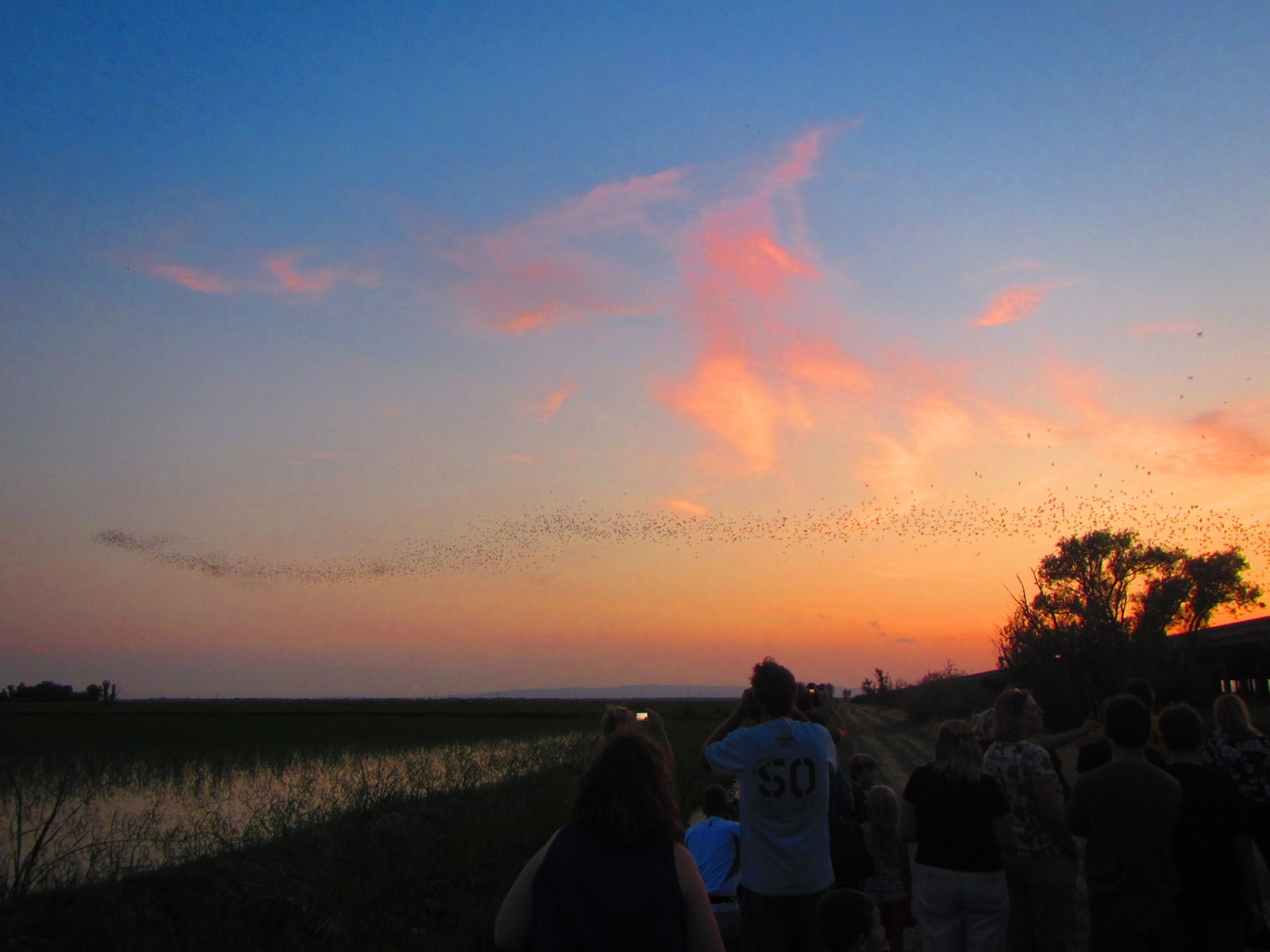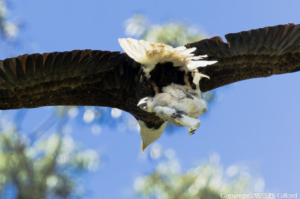The Yolo Causeway is a 3-mile viaduct on I-80 that connects the cities of Davis and Sacramento. It’s elevated because what’s below has been touted as the largest wetlands restoration project in the West — the Yolo Bypass Wildlife Area.
Drivers may see the causeway as merely a link between here and there, but in its rafters beneath a well-known bat colony makes its home in the summer months, drawn to the immense hunting opportunities of the surrounding wetlands. They need some place to roost and have babies, and apparently the causeway does the trick.
I was here for one of the Yolo Basin Foundation’s summer bat walks, guided tours to one of the largest seasonal Mexican free-tailed bat (Tadarida brasiliensis) colonies in California. An estimated 250,000 individuals strong, this colony starts returning around March from its wintering grounds in Mexico under the eastern side of the causeway. By July, it’s going pretty strong, as is summer bat season.
Engineered for Bats

It’s doubtful that the engineers planned this way. But the Yolo Causeway is structurally a bat haven. Expansion joints, designed to prevent cracks in the bridge caused by temperature change and earthquakes, also happen to retain heat, are generally inaccessible to predators, and replicate (unintentionally)cave crevices that bats feel safe in. The bats discovered the joints in the 1970s, soon after the expansion joints were installed, and took up summer residence. Engineers were at first concerned that the bats would degrade the structure, but they didn’t. The colony has been there and growing ever since, and the causeway remains structurally sound, and even a tourist attraction.
The whooshing sounds of traffic mere feet above doesn’t seem to bother these highly social mammals. Standing under the smaller colony (an estimated 5,000 bats) on the west side of the causeway, I noticed that the chirps, clicks, twitters, and other bat-gossip noise nearly drowned out the grumble of semis overhead as their collective, hyperactive chittering bounced off the concrete.
The surrounding wetlands and farmland host bat food aplenty, giving the Mexican free-tailed an insect feast all night long with plenty to spare. It’s estimated that the 250,000 bats from this one colony eat the equivalent of 500 brown-paper grocery bags of bugs per night.
What used to be 4 million acres of permanent and seasonal wetlands have been reduced 95 percent. But a busy 5 percent it is — home to the celebrity bats I was there to see, as well as a vital part of the Pacific Flyway, with millions of birds passing through to rest and rejuvenate before continuing on their long winter migrations.
A Bat Primer

Let’s dispense with the stereotypes. Bats are not blind. Most of them see in black and white, as well as if not better than us humans. Bats aren’t repelled by light. In fact, outdoor lighting is actually an “Eat Here” sign for bats because they know quite well where the insects go. Instead, their famed echolocation abilities (so useful in the night) may be an evolved trait that allowed bats to avoid daytime competition for food.
Remember, they are an exotic species in the Western United States, and are rapidly increasing their geographic range and range of habitats. Are they outcompeting or excluding native species in the process? How would we know? We have done almost nothing to monitor changes in the assemblage of mushroom species in areas before and and after the incursion of death caps.
Further Reading
Pringle et al, “The ectomycorrhizal fungus Amanita phalloides was introduced and is expanding its range on the west coast of North America,” Molecular Biology 2009
Lockhart et al, “Simultaneous emergence of multidrug-resistant Candida auris on 3 continents confirmed by whole-genome sequencing and epidemiological analyses,” Clinical Infectious Diseases 2017
Battalani et al, “Aflatoxin B1 contamination in maize in Europe increases due to climate change,” Scientific Reports 2016
To See the Bats Yourself
The public bat walks to the main colony at YBWA are extremely popular and all spots are reserved. Since the area closes at sunset, you must be registered with the bat walk to gain access into the reserve as the main colony flies from its roost.
But wait! All is not lost…
Plenty of spots are available for Yolo Basin Foundation members, and that’s the secret way that we’re telling you to get in. “I’ve known people who have signed up to be members just to come on the bat walk!” says Quirk. Memberships are $35, the walk is free to members, and you can bring two extra guests.
You can also see the smaller colony (approximately 5,000 bats) on the west side of the causeway on your own. It’s right near the entrance to the wilderness area. Swing by the Yolo Bypass headquarters to ask for directions or find it yourself. The perk to seeing the smaller colony is you’ll be able to stand right underneath as they exit, a unique viewpoint to witness these fantastic critters start their evening patrol of the skies.
Other great bat viewing areas are listed here in a previous Bay Nature article.
Of the 4,500 known mammal species, a good 1,200 of these are bats — that’s how diverse they are. Northern California has 17 species, among them the Mexican free-tailed bat, Tadarida brasiliensis . It weighs in at about a half ounce with a 12-inch wingspan, and are quite the flyers. They fly vertically upward 2 miles chasing insects and at speeds of 50-60 mph, making them notoriously difficult to study since glue-on radio transmitters tend to pop off these little acrobats.
Starting the last week of June to the first week of July these Mexican free-tailed bats give birth to one pup at a time, which is no easy feat.
“The pups are huge, about one-third of mom’s weight at birth. It’s like us giving birth to a kindergartener,” said Corky Quirk, who leads tours of the Yolo colony for the Yolo Basin Foundation.
When female free-tailed bats are pregnant or nursing, they have to eat 100% of their body weight in insects per evening — the equivalent of a 100-pound human eating 400 quarter-pounders per day!
While the moms are out hunting, the babies roost together in the highest areas, where it’s likely to be warmest and safest from predators. Once mom comes back, she’ll find her individual baby out of thousands.
The babies will nurse until they’re the size of a full grown adult. Once they learn how to fly and hunt, they’ll start eating insects.
Mexican free-tailed bats are known for roosting in huge colonies. The largest in the world is in Bracken Cave near San Antonio, Texas with an estimated 20 million individuals (the roosting site is under threat from a proposed 3,800 home subdivision next door). Other threats? white-nose syndrome, which has decimated an estimated 80% of the entire bat population in the northeastern United States since 2007, but has yet to appear (fortunately) on the West Coast.
The Main Event

Piling into cars and following each other’s taillights, our tour group drove into the heart of the wildlife area, the light fading as we bumped along dirt roads that cut across flooded rice fields. I marveled at the political and social maneuvering that must have occurred to create the hybrid wildlife preserve/agricultural area of YBWA.
We parked our cars next to a deep drainage ditch about 100 feet from the causeway and tumbled into loose formation. Docents toting baskets of bug repellant like airline hosts offering around hot towels wove through the crowd while Quirk pulled out her heterodyne, a.k.a. “bat detector”, an electronic device that translates frequencies too high for the human ear to hear into lower pips and squeaks we can comprehend.
“When the bats fly overhead, we’ll be able to hear them echolocate!” she called. “If they’ve already given birth to their pups, they’ll be out about 20 minutes before the usual time to get some extra hunting in.”
And then we waited.
Nearly a half hour of mosquito-swatting later, a gap-toothed kid looked up at me and quipped, “I think the bat walk is broken.”
“Keep the faith, dude,” I grinned back. “They’re coming.”
And then, to my left: “There! There’s one!” Fingers pointed up, I swiveled my head and caught the silhouette of skittering wings beating at the sky. “There’s another!” To my right, another singular aerial flurry so uniquely un-bird like.
And then, a gasp. Collective and unselfconscious.
I whipped my head around in time to see the bats burst from below the causeway and into the lavender evening, a blooming geyser bellowing skyward as if the bridge had sprung a leak. The heterodyne went nuts, beeping and squealing with translated noise as we stood silent and gaping.

The ribbon meandered south, the bats streaming out by the thousands. After ten minutes of marveling at the teeming formation, I glanced down to scribble something in my notebook. Looking up mere heartbeats later, there was nothing but tranquil sky. The bats were gone, off to terrorize insects and unwittingly keep us humans safe from the scourge of the six-legged.
“There’s going to be one more ribbon, but that was the main one,” said Quirk. Sure enough another battalion flowed out a few minutes later, quickly whisking out of sight across the fields.





